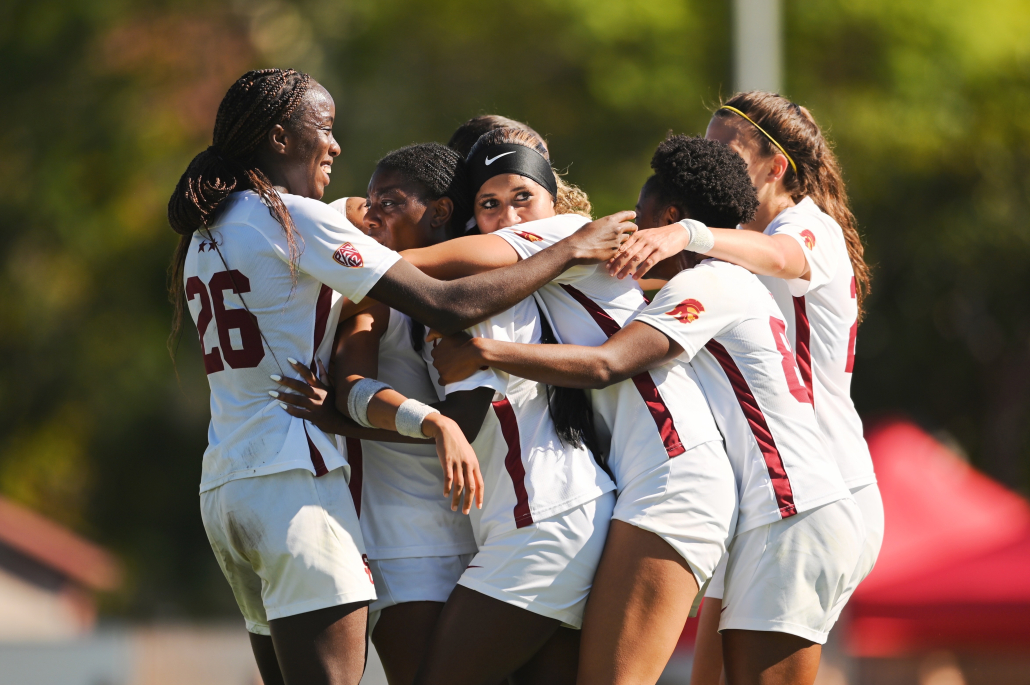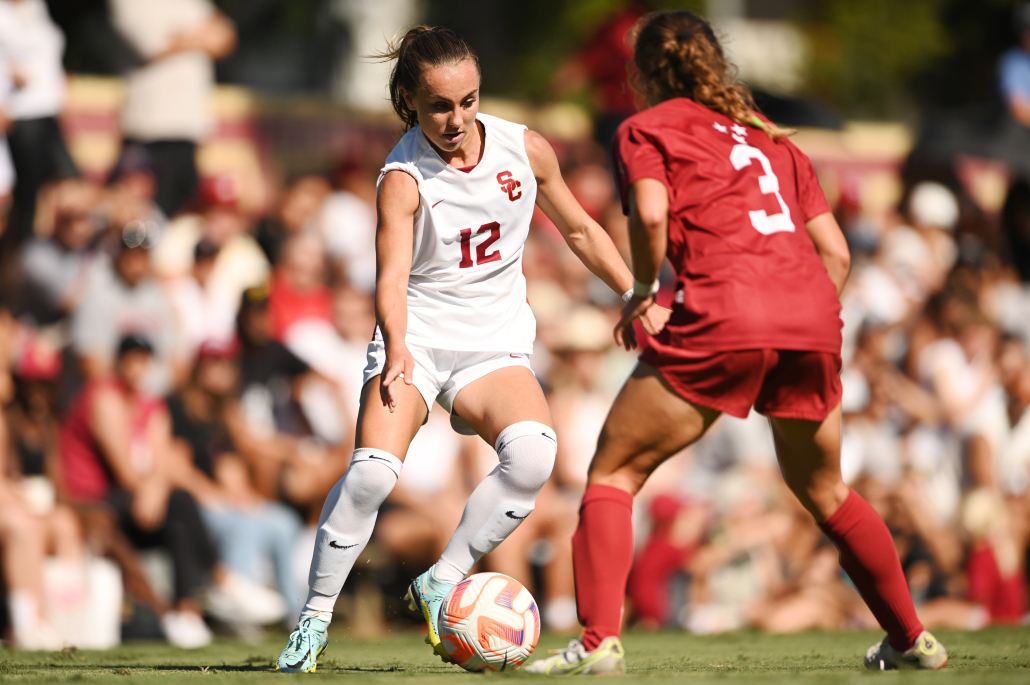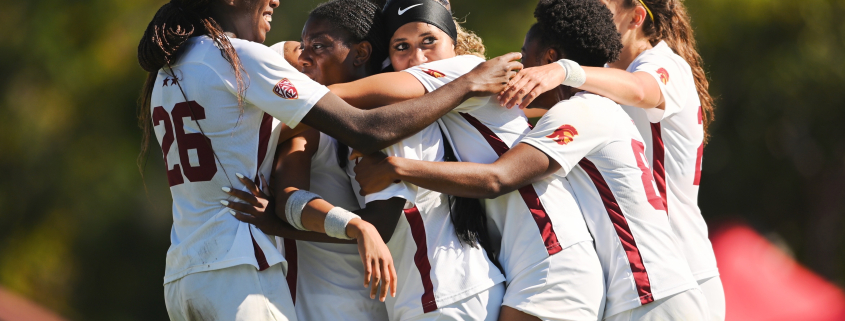The state of USC women’s soccer

The Trojans want to take the game to their opponents in 2023.
The 2022 season marked a solid debut for USC women’s soccer Head Coach Jane Alukonis and her staff but ended with a disappointing loss against lower-seeded UC Irvine in the NCAA Tournament. Once the squad resumed team activities in January, it continued to build on the solid foundation it laid in the fall and challenged itself with scrimmages against quality teams.
In an offseason sit-down with the Daily Trojan, Alukonis reflected on the prior season, discussed the team’s spring training and previewed the coming season, its final Pac-12 campaign before moving to the Big Ten.
The build-up to the 2023 season started with Alukonis and her coaches showing their squad highlights from the previous season while stressing that they underperformed against Irvine.
“We started the very first day just revisiting expectations of the program,” Alukonis said. “We wanted to make sure that the team knew we had some really good wins and some super positive times and days. But in the end, going out so early in the tournament, to us, we feel like we underachieved. So, celebrating some of the positives but also being like, ‘We are a national championship-level program.’”
Alukonis wants her team to be both versatile and aggressive in attack. In their spring training sessions, the team discussed maintaining possession of the ball but also springing forward in transition when the opportunity presents itself. It’s been a part of Alukonis’ vision since day one.
“Something that was super important to me was keeping a bit of the history of the program,” Alukonis said. “Back to when I used to play against SC” — Alukonis played college soccer at Duke — “you just had amazing attacking firepower … you always felt kind of suffocated against USC. With that, I do like a possession style, but we’re pretty clear in saying, if we can go forward and score goals … That’s always going to be the number one priority.”
But the team’s spring scrimmage schedule also allowed them to test their defense against professional opposition. They played five matches during the spring against high-quality teams, two of which were against the NWSL clubs Angel City FC and the San Diego Wave. Those matches helped the Trojans see the tempo difference between the pro and college levels.
“Angel City gave us a really amazing example of still trying to do what we would want to do but just lifting it to a professional tempo,” Alukonis said. “They had us pinned in for most of the game. We had a couple of chances but definitely had to work on our low-block defending, which isn’t ideally what we want to do.”
That match’s challenges aligned nicely with what Alukonis stresses to her players about the importance of maintaining a fast speed of play.
“We always preach, ‘tempo, tempo, tempo,’ being able to do things under the highest level of pressure or raising the speed of the game, raising soccer fitness because the game is so fast,” she said. “In that game [against Angel City], we were like, ‘OK, now do you understand what we mean when we say push the tempo, play as fast as you can, make decisions quickly, all of that?’”
Just like college sports fans have seen in football and basketball, the transfer portal affected women’s soccer’s roster during the offseason. Senior midfielder Croix Bethune and senior forward Hannah White opted to use their final year of eligibility elsewhere, returning to their shared home state of Georgia to play for the University of Georgia Bulldogs. Bethune had a strong final season in Cardinal and Gold, scoring eight goals and providing nine assists, the most of any Pac-12 player. But the departures certainly have not shaken Alukonis’ confidence in her squad.
“At the end of the day, our core group is so, so strong,” Alukonis said. “I don’t want to mention individual players, but the core of our team, the identity, the culture, the character of the core group of the program is so strong. To me, you’ll see this within any team, some of the brightest moments, the biggest wins, come down to who plays together as the best team.”

The team’s 2023 schedule should help soften the transition from the Pac-12 to its future in the Big Ten. Although the schedule hasn’t been formally released, Alukonis noted that the team will go on a road trip to face Duke, her alma mater, and the University of North Carolina, two women’s soccer powerhouses. Traveling that distance during the regular season will more closely emulate the journey to play teams like Rutgers or Penn State in 2024 and beyond. Alukonis said that they will also play the University of Michigan in the fall.
“That turnaround, going to the East Coast, playing Duke and UNC … it’s just going to be challenging and we’re going to have to rotate a lot of players,” Alukonis said. “But it’s good for us and if the goal is to win the national championship, we’re going to have to dig through some hard moments.”
The University announced June 12 that the women’s soccer and lacrosse programs will soon play their games at the new Rawlinson Stadium, scheduled to open for the 2025 season. The ground will have a 2,500 capacity for gamedays, with 2,200 fixed seats — a big upgrade from the bleachers at McAlister Field.
Just two days later, the program officially revealed its incoming class of players for the 2023 season. The group, composed of three transfers and six freshmen, has both NCAA Division I and youth international team pedigree. Trojan fans should be particularly excited about Keely Roy, an attack-minded player who scored 11 goals for Cal in the Pac-12 last season and finished seventh overall in points.
Five of the six incoming freshmen have been involved with youth international set-ups, but Maribel Flores’ resume catches the eye in particular. This month, Flores started in the final of the Concacaf U-20 Championship for Mexico, which won the match 2-1 against the United States.
Alukonis believes in her group’s talent and ability to compete at the highest level.
“To me, the level of talent on our team is extraordinary,” Alukonis said.

